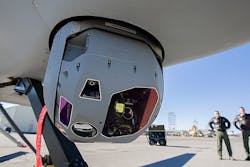Air Force orders nine Multi-Spectral Targeting Systems for French military forces
WRIGHT-PATTERSON AFB, Ohio, 27 April 2015. U.S. Air Force electro-optics experts are helping the government of France acquire airborne, forward-looking infrared turreted sensors for long-range surveillance and target acquisition for NATO laser guided munitions.
Officials of the Air Force Lifecycle Management Center at Wright-Patterson Air Force Base, Ohio, announced an $11.7 million contract to the Raytheon Co. on Friday to provide nine Multi-Spectral Targeting Systems-B (MTS-B), as well as high-definition (HD) electronic units and containers.
The Raytheon Space and Airborne Systems segment in McKinney, Texas, will build the nine MTS-B airborne infrared sensors to help French forces with forward-looking infrared, turreted sensor capability that provides long-range surveillance, high altitude target acquisition, tracking, range-finding, and laser designation for all NATO laser guided munitions.
The Raytheon MTS can be fitted to the C-130 fixed-wing aircraft, the MH-60 helicopter, and the medium-altitude long-endurance MQ-9 Reaper hunter-killer unmanned aerial vehicle (UAV).
The deal is a modification to a $191 million contract the Air Force awarded to Raytheon two years ago for MTS-B sensors, HD electronic units, containers, and spare parts. Friday's contract modification to Raytheon involves Foreign Military Sales (FMS) to France.
The Raytheon MTS is a turreted forward-looking pod combining several visible-light and infrared video cameras for long-range surveillance and high-altitude target acquisition, tracking and laser designation.
Multispectral sensors captures image data at specific frequencies, and separate the wavelengths to extract information the human eye fails to capture with its receptors for red, green and blue. It can detect things like disturbed dirt, and can be effective in finding targets hidden in camouflage.
The MTS offers a combination of sensors that include multiple-wavelength sensors; near-infrared and color daylight TV cameras; illuminators; eyesafe rangefinders; image merging; spot trackers; and similar other avionics, Raytheon officials say.
The system offers surveillance, target acquisition, tracking, rangefinding, and laser designation for the Hellfire missile and for all tri-service and NATO laser-guided munitions such as the Paveway laser guided bomb.
The advanced targeting forward looking infrared (ATFLIR) pod also is used with used with Paveway, JSOW, and HARM bombs and missiles. The MTS sensors carry the military designations of AAS-52, AAS-53, ASQ-228, DAS-1, and DAS-2.
On the MTS contract announced Friday Raytheon will do the work in McKinney, Texas, and should be finished by December 2016. For more information contact Raytheon Space and Airborne Systems online at www.raytheon.com, or the Air Force Lifecycle Management Center at www.wpafb.af.mil/aflcmc.

